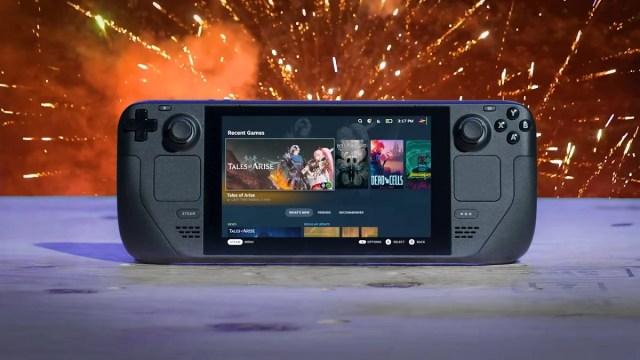It’s already been well established that the Steam Deck and its mid-generation OLED refresh are not even remotely the most powerful handheld gaming PCs. Valve’s niche, instead, has been to focus on ease of use, a low power draw, and extreme customizability, the latter thanks to Deck’s burgeoning community.
Indeed, the fact that Valve was the first to release a mainstream PC gaming handheld does mean that the Deck is 30-50% weaker than the newer devices, like the Lenovo Legion GO. It also means, however, that Valve had an early start on building a substantial user base that developers and companies could hone in on with products and upgrades.
This has resulted in a truly impressive array of aftermarket upgrades and third-party software for the Steam Deck, allowing anyone to hugely improve their experience using it. Down below, we’ll introduce you to some of our favorite Steam Deck upgrades, and explain what makes them such a big deal in the first place.
Best Steam Deck mods to elevate the device to an all-new level
Before we begin, something we’d like to highlight is that any and all hardware mods outlined in this article might not apply or be necessary for the early adopters of the Steam Deck OLED. Note that Valve has hugely revamped the device’s internals to accommodate the new display (among other things). Externally, however, the Steam Deck and the Steam Deck OLED are supposed to be identical, so outer mods should work just fine!

#10: Install custom Hall effect joysticks
For those who came to the Deck from the Nintendo Switch, it is highly likely you experienced joystick drift on the Nintendo device in the past. Notably, the standard potentiometer-based joystick, used in the vast majority of modern gamepads and the Deck itself, will develop drift eventually due to its tech.
Hall-based joysticks do away with potentiometers, however, and leverage magnets for movement instead. This means that Hall effect joysticks, like the ones made by GuliKit, should feel snappier, smoother, and won’t develop joystick drift as their parts don’t rub onto one another. It’s a neat upgrade, though it’s not really a must-have, from personal experience.

#9: Check out third-party cases
As the Deck is a relatively expensive device, protecting it is an obvious imperative for most users. Thankfully, Valve ships the device in a custom hardcase of its own design, which will be enough for a huge variety of use cases.
That being said, there’s a huge selection of aftermarket Deck cases for a more niche setup. From TomToc’s lithe carry case to dBrand’s integrated armor system, rest assured that there is a perfect Steam Deck protector on the market for you, too. You just gotta find the one that fits you best.

#8: Accessorize (the hard way)
Accessorizing your Deck is an obvious way to make the device truly your own. From personal experience, however, we can attest to there being two levels of accessorization difficulty for the Deck. The one this section is dedicated to is not recommended to newbie techies, as it includes essentially a full disassembly of your Deck, including the process of peeling your screen out of the baseline chassis.
However, we will admit that ExtremeRate’s custom Deck shells do look quite neat in a retro sort of way. For those who grew up with Nintendo’s legendary Atomic Purple gear, now’s your chance to give in to the nostalgia. And, hey, there’s woodgrain, too, if that’s your sort of thing.

#7: Accessorize (the easy way)
If a full shell swap sounds like way too much work for way too little of a reward, we do not blame you. Why risk breaking your awesome new handheld just to make it transparent, right? We do have some good news on that front, though.
For one, setting up a custom backplate, like the ones made by JSAUX, is as easy as pie on the Deck. And as for the front, investing in a higher-quality 3M-based vinyl wrap could be the way to go. The only reason we recommend splurging on more expensive vinyl for the Deck is that the cheaper versions do not come off easily.

#6: Install CryoUtilities
The first major software upgrade you can make to your Deck is to install CryoByte33’s suite of Steam Deck utilities. The so-called CryoUtilities package comes with a bundle of low-overhead customizations that help the Deck manage its storage more efficiently and, in some cases, improve performance while gaming.
CryoByte explains all of their changes in a very comprehensive FAQ document on their GitHub, and we recommend going over it to see if your use case could be improved by the installation of these changes. Note that the recent SteamOS update 3.5.5 does make some of CryoByte’s changes arguably unnecessary, which is also why CryoUtilities aren’t higher up on this list.

#5: Get a good battery bank
For those who aim to actually use their baseline Steam Deck outside for relatively long periods of time, we recommend investing in a high-quality battery bank to keep the device topped up. You know, just in case.
The thing to keep in mind here is that not every old battery bank will work. You will need to splurge a bit on a higher-end 45-watt powerhouse, due to the device’s higher power draw. At the same time, ultra-fancy, super-expensive choices like the Shargeek Storm 2 are not necessary at all. Xiaomi, Anker, and other reputable gadget companies will have you covered.

#4: Invest in DeckMate
DeckMate is a utility powerhouse for the Deck. For those who saw Valve’s rather cool OLED announcement trailer, they appear to have used DeckMate to set up their Steam Deck rigs just right, which is a testament to the attachment’s value. This is, quite simply, a way to accessorize your Deck with mounting points, SD card slots, stands, and other hardware, just to list a few options.
The baseline DeckMate chassis non-destructively clips onto the Deck, and it’s quite stealthy, to boot. From that point on, you’re given a solid attachment point for anything you’d like to slap onto your Deck. And, what’s really notable here is that the creator of DeckMate, Siri, provides everything you need to print your own DeckMate from the ground up.

#3: Install a bigger SSD
This one’s really simple, admittedly, but few things will add to your Deck’s utility as much as a larger internal storage capacity. Of course, SD cards will be more than enough for smaller and less intensive tasks, like emulation for example. If, however, you aim to play newer, larger games on your Deck, loading times off of a mid-tier SD card can get somewhat egregious.
So, you’re going to want to invest in a good, reputable M.2 2230 NVME SSD drive, which doesn’t come cheap. The installation is quite easy, and we recommend following iFixit’s Deck disassembly guide to get it done.

#2: Set up DeckyLoader
DeckyLoader is one of those software tweaks you’re going to install once, and then wonder how did you ever live without them. They’re largely unnecessary, if we’re being honest, but the plugins DeckyLoader gives you access to allow you total control over your Deck’s software, which includes ample customization options.
In short, DeckyLoader allows you to set your Steam Deck up precisely the way you like it. From the functionality and looks of your home screen to EmuDeck integration, DeckyLoader lets you do it all, and we cannot recommend it enough.

#1: Install EmuDeck
Finally, there’s the single biggest upgrade you could make to your Steam Deck: to open it up for game emulation. EmuDeck is an impressively comprehensive one-stop-shop solution for all your game emulation needs on the Deck. Of course, you do still need to provide your own games to play and set things up yourself, but EmuDeck will integrate your emulation library with your regular Steam library like they’re one and the same.
When you get things going properly, EmuDeck titles will not stand out from the rest of your repertoire in any way, shape, or form, to the point where it might seem like you’re playing them natively on the Deck. Then there are all the other goodies, like awesome CRT-emulating shaders, cloud backups, and a wealth of other options to choose from.






Published: Nov 20, 2023 01:44 pm